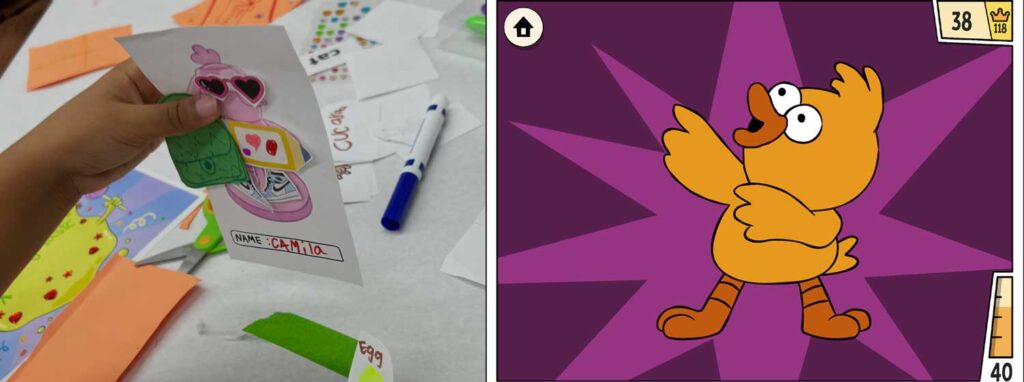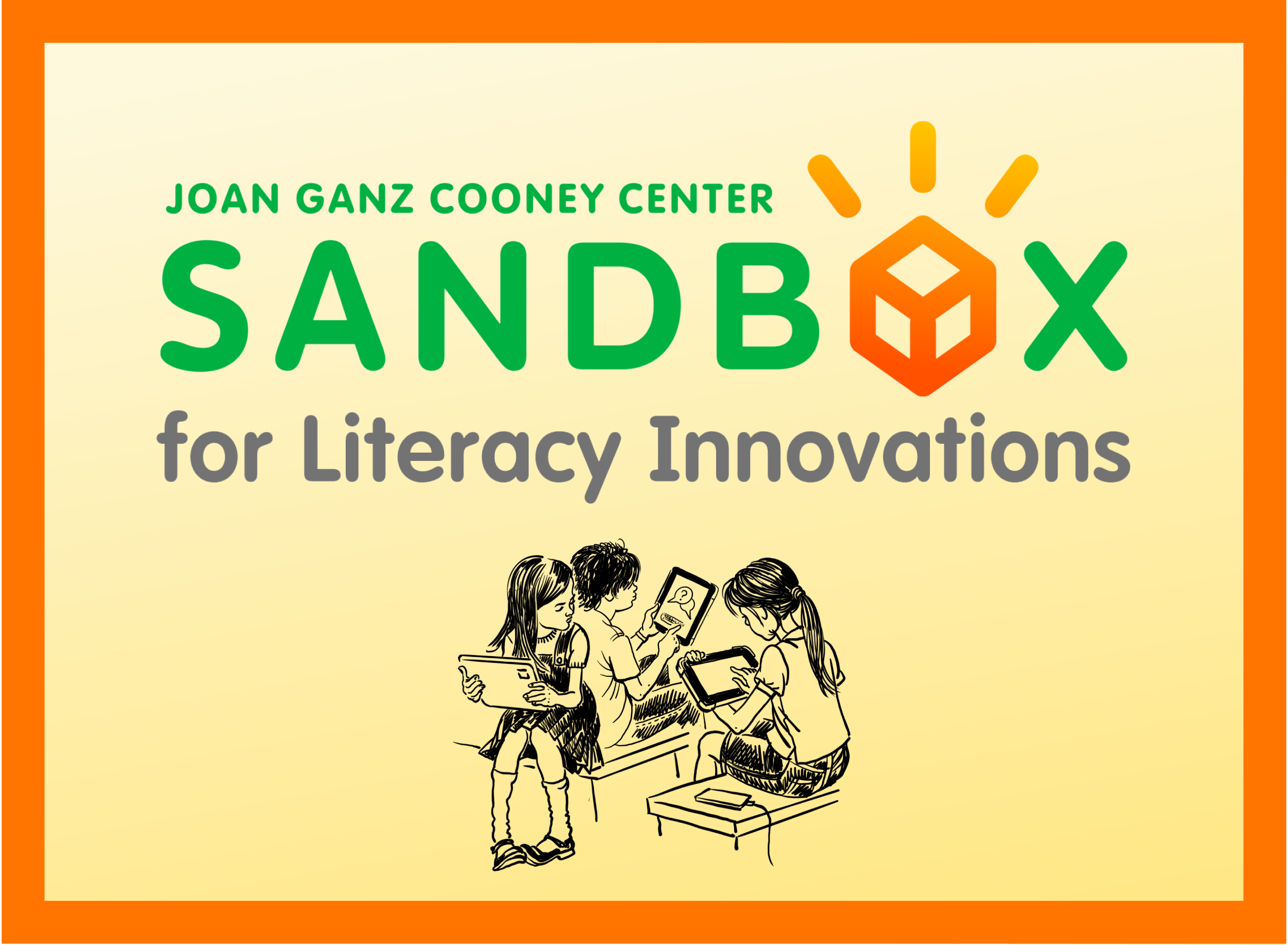On a recent October afternoon, an eight-year-old girl in a pink sweatsuit with matching bows in her hair made her way to the stage—a poster-sized paper taped to the floor of an activity room with the word “stage” scrawled across it. Her audience included half a dozen kids aged 6 to 8 and several adults who had gathered for three consecutive afternoons to co-design ideas for new app-based games to help kids learn to read.
The girl gripped her game’s main character, a penguin cut from yellow construction paper, in one hand and used her other hand to lay out some of the words for players to identify—food words if the penguin gets hungry or clothing words if it’s chilly. Successful readers win the penguin’s appreciation in the form of a giant heart and a silly dance.

The audience laughed. This was fun, but it was serious fun. The insights from these three co-design sessions would inform a suite of new reading games for kids aged 5 to 10 called Superfonik, developed by the team at Piknik; a publisher of leading kids apps (among them Sago Mini and Toca Boca Jr), and a partner in the Cooney Center Sandbox for Literacy Innovation. The co-design sessions were facilitated by The GIANT Room, an organization that promotes kid-centered learning innovation; the goal was to maximize engagement in the Superfonik games among new readers, because kids have unique expertise in what they find fun and engaging.
“We have no shortage of ideas generated by adults,” noted Youngna Park, Superfonik’s product lead. “But, it’s always good to check yourself and think, well, what would a kid want to see? And kids know kids better than adults know kids.”
Co-Design: Kids Offer a Fresh Take on Literacy Games
Engagement is always critical for learning, but it’s especially critical for an app like Superfonik, which was conceived in the wake of pandemic school disruptions to motivate the growing numbers of struggling and reluctant readers. They created the app for kids who needed some extra help with reading, but through a more playful and fun approach than what they’re getting at school or from typical early readers. but had outgrown the typical early-reading books.
Consequently, the game designers took their cue from comic books and graphic novels, creating crazy characters such as surfing aliens, zombies, and baby burglars to populate more than 25 fast-paced “mini-games” geared to early literacy skills. In one game, for instance, a secret agent dog must escape captivity by punching in a code on a keypad of images corresponding to four words spelled out on the screen. In another game, a hungry frog uses his very long tongue to snag objects floating by on lily pads that match words on the screen while dodging electric eels. In all the games, clicking on a word engages a tool that helps kids with decoding by sounding out words phoneme by phoneme.
Pikniki has released an “early access” link where parents and teachers can sign up to try out this first suite of Superfonik games and offer feedback. They’ve also conducted extensive playtesting of their app with kids. But the Superfonik team is eager to expand and improve their game offerings as they work toward a broad global release in early 2026 and beyond. Through their literacy consultations as part of the Cooney Center Sandbox for Literacy Innovations, they’d already received recommendations and insights from experts in the science of reading and universal design for learning. For instance, the team changed the app’s algorithm based on the Cooney Center literacy team’s advice to follow a structured phonics sequence and pace the introduction of new literacy skills as players improved their reading.
According to Sarah Eldershaw, a senior designer on Superfonik, she and her colleagues saw co-design as a chance to “sort of start fresh, to build on our solid library of games but think about, what are we missing and how these kids could help us fill in those blanks.”
This desire to start fresh was evident in their first co-design session. They deliberately avoided introducing their app and its existing characters and simply prompted kids to talk about their favorite games and to dream up their own characters, settings, and games using paper, pipe cleaners, cardboard, markers, and tape.
“We wanted to see what they would come up with right off the bat, without knowing anything about who we are, who our characters are, or what our games look like,” said Adrianna Ruggiero, Piknik’s user researcher. “That’s when you get the most genuine ideas from kids.”
The adults’ role in these sessions was to prompt the kids’ imaginations, to mix in their own ideas, and to help turn fragments into full-blown game concepts. According to Eldershaw, one of the day’s big takeaways was that “kids love to customize” their games. For instance, when one boy expressed interest in creating a racing game, questions from curious adults led him to envision an entire auto shop where players who successfully matched words with objects could earn credits for adding elaborate decorations and functionality to their racing vehicles.
“That kind of customization is not something that’s part of the games we currently have,” said Eldershaw. “We knew it was an idea kids would find interesting, and this session really reinforced that.”

Bolstering Engagement With Kid-Character Connections
The second and third days of co-design were a mix of playtesting Superfonik games and creating or refining kids’ ideas for new characters, settings, and game play. One of the themes to emerge was that kids craved more reactions and interactivity from game characters. For instance, one boy tired of a game set in space where reading guided a ray gun that blasted objects—one after another after another. His idea for a new game was a ship that lost its cargo overboard in a storm, requiring reading to help a scuba diver recover the goods; the reward would be a lavish boat party replete with dancing and fireworks.
Likewise, the kids also wanted feedback on their reading performance from the characters themselves—rather than from a disembodied voice or graphic at the end of the game. The girl creating the penguin game, for instance, reacted to a character’s triumphant dance in another Superfonik game by demonstrating an improved dance routine. “More energy!” she exclaimed while twisting and grooving. “Like this!”
“This was an unusual opportunity to work with these kids on three consecutive days,” said Park. “It’s really different, to be in the room with them, to watch them physically responding to these characters, by dancing or laughing.”
The Superfonik team said they were eager to mix in more reaction animations for reading success. One big idea to be fast-tracked from the co-design sessions is a game called “Chickie Boogie.” Originally conceived as a chicken’s birthday party in which spelling words opened presents, the object of the new game is to hatch the chicken’s eggs and let the new chicks free to dance in celebration.

They also discussed adding animations for too many mistakes, such as a chicken character emitting a bug-eyed shriek or a blob character melting, but they recognized the risk of tempting kids to mess up on purpose just for kicks.
Some of the ideas would be harder to incorporate, at least for the current crop of game offerings. For instance, several of the young co-designers wanted the featured words to be relevant or useful to the game’s characters (food words for the hungry penguin, for instance). This suggestion would be tricky for the current games that are designed to present words following a specific sequence of phonics instruction not thematically based on the game’s context.
“Any level of word can funnel into each game,” Eldershaw explained. “So, the games are basically vessels for the words, so there’s a sort of randomness that makes the game really silly.”
However, making words more character-relevant might be possible down the road, as Superfonik builds up its word lists and adds more challenging types of games that focus on skills such as sight words and sentence construction. Indeed, Ruggiero said she’d love to start the co-design process earlier in the product development cycle next time.
“We’re always working under such fast timelines. For Superfonik, we were so far into development, even though we got amazing feedback, and it was still incredible,” she said, “but for our next big product, I would love to do something like this before ideas have already been generated, kind of like a kickoff session for the team.”

